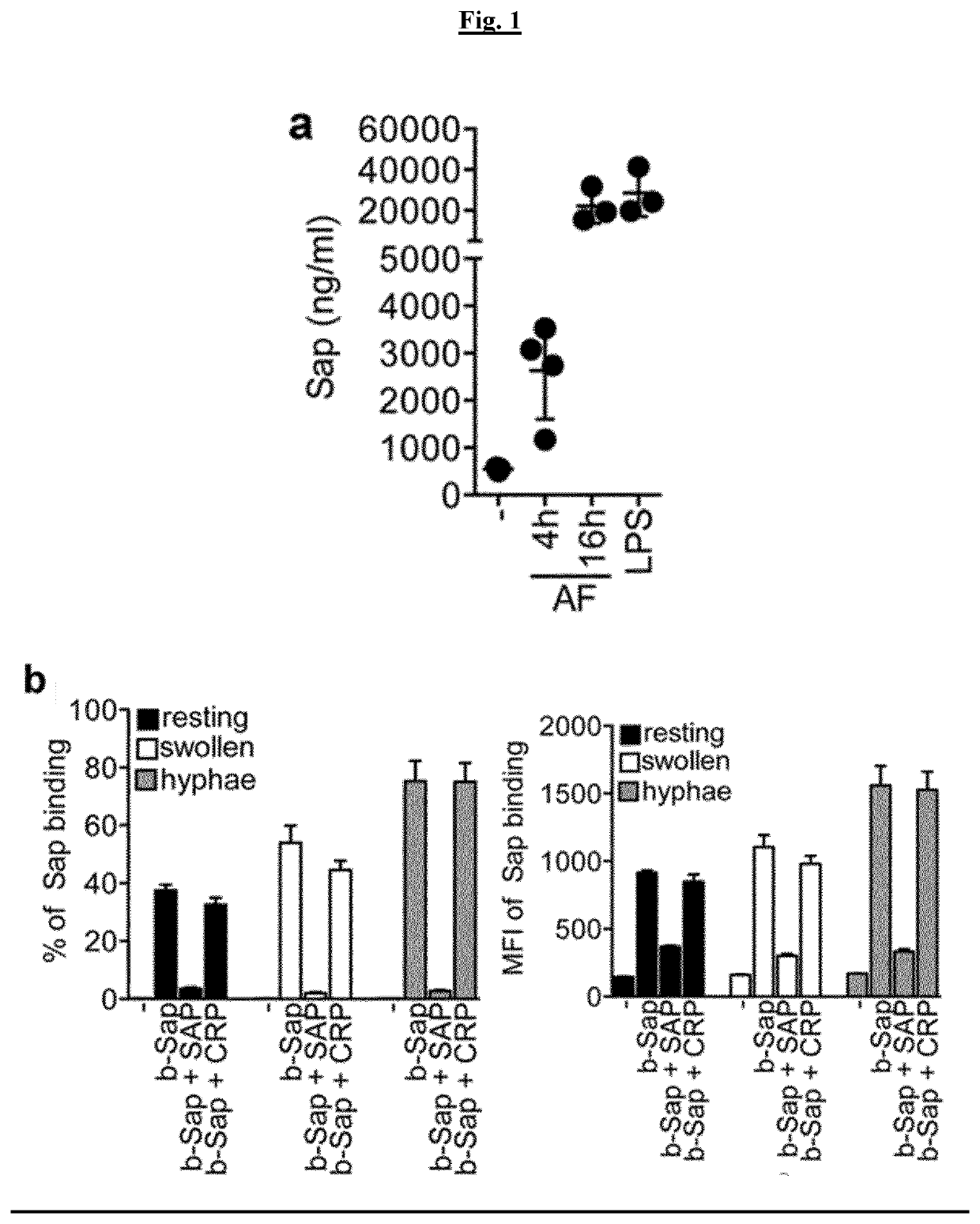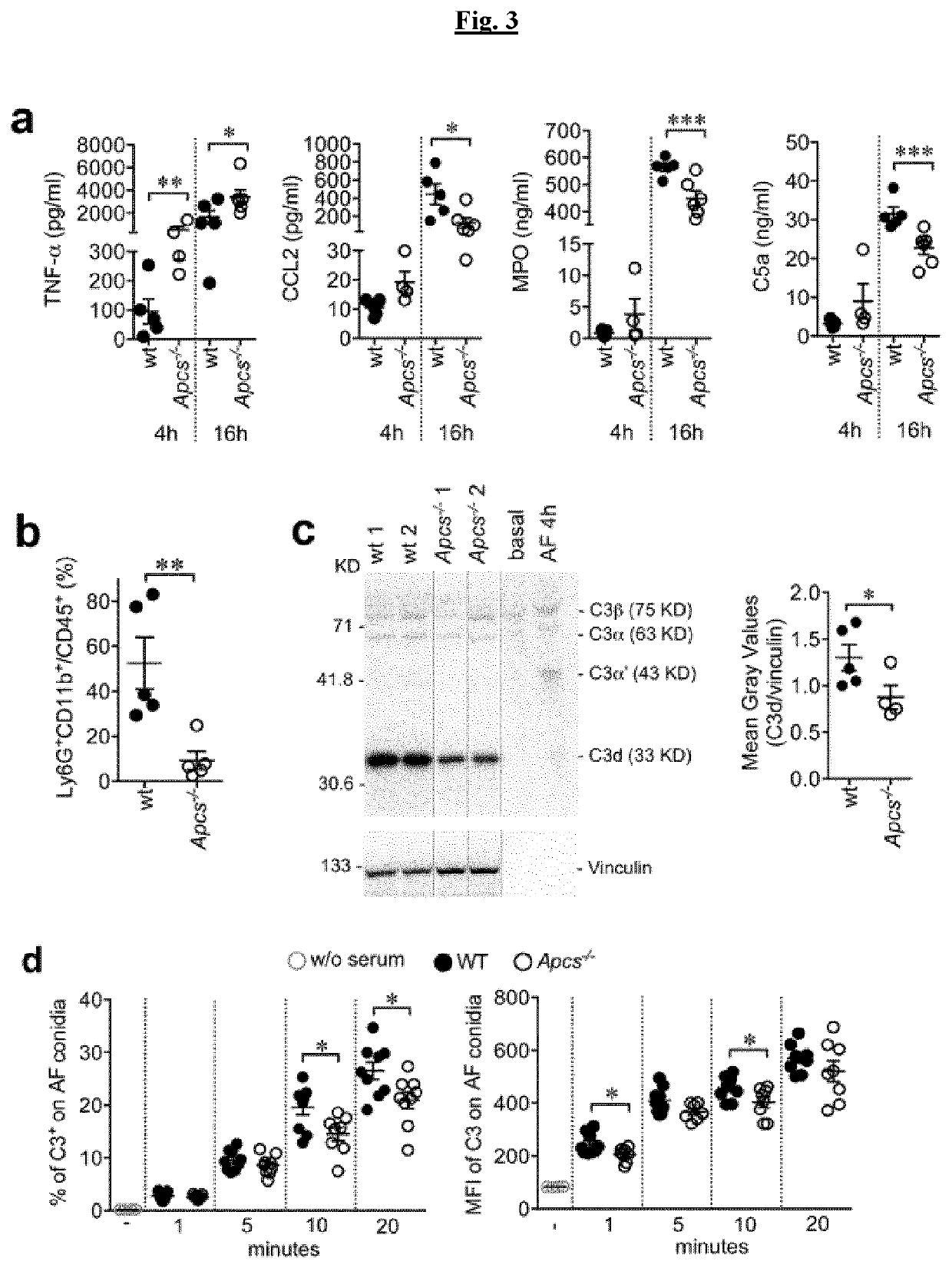Use of sap for the treatment of eurotiomycetes fungi infections
a technology of serum amyloid p component and sap, which is applied in the field of sap for the treatment of eurotiomycetes fungi infections, can solve the problems of difficult extrapolation of observations related to the function of short pentraxins in mice, the effect of sap on pulmonary innate immunity against tuberculosis or malaria, and the inconclusive study of crp and sap
- Summary
- Abstract
- Description
- Claims
- Application Information
AI Technical Summary
Benefits of technology
Problems solved by technology
Method used
Image
Examples
example 1
[0077]FIG. 1 depicts the interaction of SAP with A. fumigatus conidia in mice. a) induction of SAP circulating levels after i.t. injection of 5×107 A. fumigatus (AF) conidia; LPS, 0.8 mg / Kg. Mean±SD. c) FACS analysis of binding of biotin-conjugated (b-) murine SAP (Sap; 10 μg / ml) to viable dormant or germinating conidia of AF (1×108). Human SAP (50 μg / ml) and CRP (50 μg / ml) were also used. Mean±SD of one quadruplicate experiment of two performed.
[0078]FIG. 1a shows increased circulating levels of SAP (0.55±0.43 μg / ml; n=3) at 4 (2.63±1.02 μg / ml, n=4) and 16 h (22.12±8.50 μg / ml, n=3) comparably to those observed after LPS administration (28.47±11.43 μg / ml, n=3; LPS, 0.8 mg / Kg, 16 h) Confocal microscopy analysis not shown here shows that in lungs (n=3; 4 h), SAP localized areas of cell recruitment and complement deposition closely associated with conidia. This data also shows that recombinant murine SAP (Sap; 10 μg / ml) bound viable dormant, swollen and germinated conidia, as assessed ...
example 2
[0079]FIG. 2 depicts the susceptibility of SAP-deficient mice to A. fumigatus. a,b) survival of wt and Apcs− / − mice after i.t. injection of 1×108 (a) or 5×107 (b) conidia; wt, n=9 (a) or n=6 (b); Apcs− / −, n=9 (a, b).*, P7 fluorescein-labelled AF conidia. The figure shows results of two pooled experiments. Mean±SEM.*, P<0.05 (unpaired t-test).
[0080]Apcs− / − mice showed lethal infection with a median survival time (MST) of 3 days compared to MST>10 of wt, both when 1×108 (FIG. 2a) or 5×107 (FIG. 2b) conidia were used. Actually, 89.9% ( 8 / 9) (FIG. 2a) and 44.4% ( 5 / 9) (FIG. 2b) of Apcs− / − mice succumbed on day 3 compared to 23.8% ( 2 / 9) and 0% ( 0 / 6) of wt mice. At the end of the experiment, 11.1% ( 1 / 9) and 33.3% ( 3 / 9) of Apcs− / − mice survived to infection compared to 55.6% ( 5 / 9) and 83.3% (⅚) of wt mice, respectively when 1×108 (FIG. 2a) or 5×107 (FIG. 2b) conidia were used. In lung, susceptibility of Apcs− / − mice was associated with 6-fold increase of A. fumigatus CFU [median, 1.9×...
example 3
[0081]FIG. 3 depicts the inflammatory response to A. fumigatus. a) cytokines, Myeloperoxidase (MPO), C5a levels in BALFs after injection of 5×107 AF conidia. One experiment out of two performed. Mean±SEM.*, P7 AF conidia. N=5 wt and n=4 Apcs− / − mice, two representative loading per genotype are shown (10 μg / lane of proteins); 1 μl / lane of mouse plasma in basal conditions and 4 h after AF injection. Vinculin used as loading control is also shown. Right, results are expressed as mean±SEM grey values of C3d / vinculin.*, P7).*, P<0.05 (unpaired t-test). One experiment out of four performed using serum or plasma.
[0082]FIG. 4 depicts inflammatory response in injured tissue. a) FACS analysis of neutrophils recruitment at skin wound site (day 2). b) MPO content in wound lysates in normal skin or 2 days after injury. a, b, mean±SD;*, P− / − mice. Scale bar, 100 μm. Right, measurement of wound granulation tissue by image analysis. Mean±SD*, P− / − (n=7) mice and quantification of the immunoreactive...
PUM
| Property | Measurement | Unit |
|---|---|---|
| Fraction | aaaaa | aaaaa |
| Fraction | aaaaa | aaaaa |
| Fraction | aaaaa | aaaaa |
Abstract
Description
Claims
Application Information
 Login to View More
Login to View More - R&D
- Intellectual Property
- Life Sciences
- Materials
- Tech Scout
- Unparalleled Data Quality
- Higher Quality Content
- 60% Fewer Hallucinations
Browse by: Latest US Patents, China's latest patents, Technical Efficacy Thesaurus, Application Domain, Technology Topic, Popular Technical Reports.
© 2025 PatSnap. All rights reserved.Legal|Privacy policy|Modern Slavery Act Transparency Statement|Sitemap|About US| Contact US: help@patsnap.com



